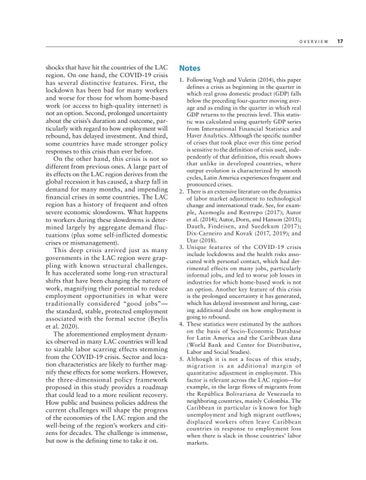O v e r v i e w 17
shocks that have hit the countries of the LAC region. On one hand, the COVID-19 crisis has several distinctive features. First, the lockdown has been bad for many workers and worse for those for whom home-based work (or access to high-quality internet) is not an option. Second, prolonged uncertainty about the crisis’s duration and outcome, particularly with regard to how employment will rebound, has delayed investment. And third, some countries have made stronger policy responses to this crisis than ever before. On the other hand, this crisis is not so different from previous ones. A large part of its effects on the LAC region derives from the global recession it has caused, a sharp fall in demand for many months, and impending financial crises in some countries. The LAC region has a history of frequent and often severe economic slowdowns. What happens to workers during these slowdowns is determined largely by aggregate demand fluctuations (plus some self-inflicted domestic crises or mismanagement). This deep crisis arrived just as many governments in the LAC region were grappling with known structural challenges. It has accelerated some long-run structural shifts that have been changing the nature of work, magnifying their potential to reduce employment opportunities in what were traditionally considered “good jobs”— the standard, stable, protected employment associated with the formal sector (Beylis et al. 2020). The aforementioned employment dynamics observed in many LAC countries will lead to sizable labor scarring effects stemming from the COVID-19 crisis. Sector and location characteristics are likely to further magnify these effects for some workers. However, the three-dimensional policy framework proposed in this study provides a roadmap that could lead to a more resilient recovery. How public and business policies address the current challenges will shape the progress of the economies of the LAC region and the well-being of the region’s workers and citizens for decades. The challenge is immense, but now is the defining time to take it on.
Notes 1. Following Vegh and Vuletin (2014), this paper defines a crisis as beginning in the quarter in which real gross domestic product (GDP) falls below the preceding four-quarter moving average and as ending in the quarter in which real GDP returns to the precrisis level. This statistic was calculated using quarterly GDP series from International Financial Statistics and Haver Analytics. Although the specific number of crises that took place over this time period is sensitive to the definition of crisis used, independently of that definition, this result shows that unlike in developed countries, where output evolution is characterized by smooth cycles, Latin America experiences frequent and pronounced crises. 2. There is an extensive literature on the dynamics of labor market adjustment to technological change and international trade. See, for example, Acemoglu and Restrepo (2017); Autor et al. (2014); Autor, Dorn, and Hanson (2015); Dauth, Findeisen, and Suedekum (2017); Dix-Carneiro and Kovak (2017, 2019); and Utar (2018). 3. Unique features of the COV ID-19 crisis include lockdowns and the health risks associated with personal contact, which had detrimental effects on many jobs, particularly informal jobs, and led to worse job losses in industries for which home-based work is not an option. Another key feature of this crisis is the prolonged uncertainty it has generated, which has delayed investment and hiring, casting additional doubt on how employment is going to rebound. 4. These statistics were estimated by the authors on the basis of Socio-Economic Database for Latin America and the Caribbean data (World Bank and Center for Distributive, Labor and Social Studies). 5. Although it is not a focus of this study, m ig rat ion is a n add it iona l m a rg i n of quantitative adjustment in employment. This factor is relevant across the LAC region—for example, in the large flows of migrants from the República Bolivariana de Venezuela to neighboring countries, mainly Colombia. The Caribbean in particular is known for high unemployment and high migrant outflows; displaced workers often leave Caribbean countries in response to employment loss when there is slack in those countries’ labor markets.

